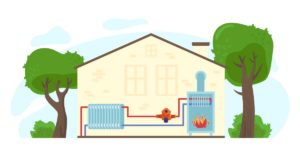
Furnaces
The central component of a forced-air heating system is a furnace. Powered by oil, natural gas, propane, or electricity, a furnace heats the air that is then pushed through ducts via an attached blower. Home heating oil is stored in an external oil tank, fed into the furnace via supply lines, and is filtered before it enters the oil burner.
Oil Burners
Boiler-based home heating systems utilize oil, natural gas, electricity, or even wood pellets to generate steam or hot water that is used to heat the home via radiators or coils. Homes that have radiant heating use boiler-based heating systems.
An oil burner is critical for both forced air and steam heat systems. It ignites heating oil, which then heats air or water and can be attached to an oil furnace, water boiler, or a boiler. When oil enters the pump, it is pushed through a nozzle at high pressure and transformed into a mist, which is then lit by a spark provided by an ignition electrode. Without an oil burner, your water boiler can’t produce hot water for showers or food, and your furnace won’t make hot air for heat.
Filters
The next heating system component to be familiar with is the filters. There are two sets of filters on your furnace. The oil filter is located along the supply line and should be changed at least twice during the winter. The other system filter is between the return air duct and the blower. Since this filter directly impacts air quality as it traps dust, dirt, and allergens, it should be checked at least once a month and changed as often as necessary, depending on how much debris gets accumulated in it.
Air Handling Units
Your heating system’s air handling unit is more than just a component; it is the central part of the furnace itself. The air handling unit or AHU controls and circulates the air and houses system filters, heating and/or cooling elements such as air coils, control components, humidifiers, and fans. AHUs used in residential homes may only include filters, air coils, and a blower. Large air handling units used for commercial HVAC are housed on building rooftops.
Fan Units
The final component that you should know about is the fan unit, located outside of your home. The fan itself is found on the side or top of the unit. Inside the unit is the compressor, which provides increased air or gas pressure when needed, and the condenser coil, which helps cool the heating system.
Oil System Maintenance and Repair Service
When it’s time for you to get your heating system serviced or upgraded, call the experts at Tragar. We offer a full range of professional repair services for oil heat and gas heat systems. Our parent company, Tragar, has been serving Nassau County and Suffolk County residents for over 60 years with our guaranteed 5-star customer service. For information about heating system upgrades or to schedule a COD oil delivery, call Tragar Express today at (516) 206-3805. You can also email us at info@tragarexpress.com.



